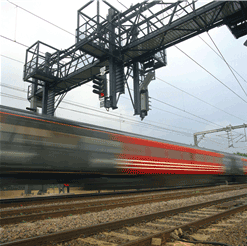Technology and innovation to deliver a better railway
Posted: 26 September 2011 | | No comments yet
A unique approach by Network Rail to use technology and innovation to provide a better and more cost effective railway is on course…


A unique approach by Network Rail to use technology and innovation to provide a better and more cost effective railway is on course to deliver savings of nearly £40m by 2014.


A number of proposals are now being investigated in more detail and several are being put into practice across the network.
One solution being implemented by Network Rail is a camera which can spot defects on the overhead rail wire 25ft above the operator’s head while another is helping to deliver savings of 90% against the cost of sleepers being used in the Thameslink project.
Thameslink required a railway sleeper capable of housing a 53mm conductor rail as well as signalling and track cables. The original plan was to use a full depth sleeper with baseplates – 65mm deeper than adjacent sleepers – which would be expensive and difficult to install and maintain. The innovation portal uncovered a solution from Cemex which has seen a wider, shallower sleeper with cast-in housings produced which deliver cost savings of 90% against existing products, expected to be around £4m by 2014.
The OLE cameras, developed with Kongsberg Maritime Limited, can be operated without the need to turn off the power along the wires or close the line. This will mean a more efficient and accurate maintenance programme, fewer delays to passenger and freight services and will save millions of pounds in delay payments.
Two solutions being investigated in more detail are acoustic curtains, which provide simple, quick and effective noise control to reduce the impact on nearby houses during maintenance and safety fences, which clip onto the rail during maintenance and provide a safe working environment while still allowing trains to pass on nearby tracks.
The innovation portal has four stages – think, explore, prove, do – which when completed help to deliver value and efficiencies to the railway.
Now, to develop the initiative further and encourage a new wave of proposals, Network Rail is encouraging businesses, universities and research institutes to consider how they could have a positive influence on the future of the railway.
Steve Yianni, Network Rail’s director of engineering, said: “There has been a fantastic response from businesses at home and abroad which we predict will help Network Rail make savings of around £38m by 2014. We have been impressed by the thinking and enthusiasm to help make the railway safer, more efficient and more cost effective and are keen to develop the initiative further as there is the potential to deliver even greater savings between 2014 and 2019.
“As well as working with established suppliers, we are keen to hear from organisations from outside the traditional rail industry which could help improve the railway. We are committed to delivering a better, safer railway that maximises value for money and are keen to work with any organisation which can help us achieve this.”
Applicants need to ensure their proposals fit one of Network Rail’s challenges, the list of which is reviewed and refreshed every month. Proposals must be fundamentally new and different, solve a particular problem and have a strong business case. Each proposal will be assessed by a specially assigned innovation supply chain manager to see whether the idea should be taken forward and developed further.
To see Network Rail’s current specific challenges and priorities visit www.networkrail.co.uk/brightideas



